Cartoons as resistance: Artists find their voice in July uprising
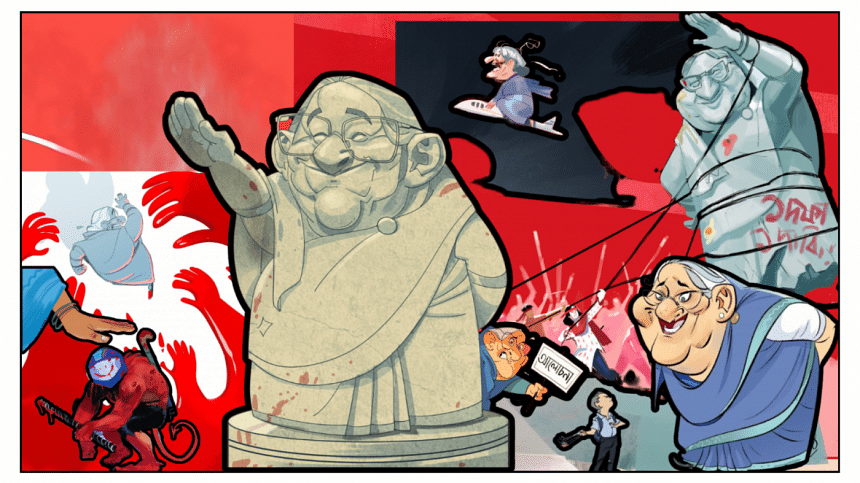
During the anti-discrimination student movement in July, the more the government tried to suppress dissent, the more unstoppable the people became. Among the tools of resistance, cartoons emerged as a powerful weapon of protest. The satirical illustrations, like sparks of rebellion, captured the essence of the time and pointed fingers at the powers that be.
One striking cartoon from May 2018 by Mehedi Haque depicted the former prime minister Sheikh Hasina cutting the fuse of a bomb labelled "Quota Reform Movement," thinking the problem was solved. However, the faint fire in the background symbolised an inevitable explosion. Six years later, that explosion shook the nation in July and subsequently forced the "fascist" Hasina to flee her throne in August.

Cartoons, as a form of artistic activism, speak the language of time. They highlight contemporary political events and societal absurdities, often at great personal risk to the artists. Despite the former AL-led government's attempts to instil fear during the anti-discrimination student movement, the people's resolve only grew stronger. Cartoonists were no exception, capturing the then government's atrocities—murders, repression, and abductions—in powerful images that spread like wildfire across social media. These cartoons became the movement's fuel, igniting further resistance.

During the 20-day student-led mass uprising, professional and amateur cartoonists alike created at least 500 cartoons. Shared by millions on social media, these illustrations fueled an "artistic/cartoon revolution."
Prominent cartoonist Mehedi Haque, along with emerging talents like Mahatab Rashid, and Natasha Jahan, discussed the significance of cartoons with The Daily Star in an exclusive interview, particularly those centred on the July mass uprising.
Cartoons, they argue, are a unique language that connects directly with the masses, whenever justice falls short to serve them. While thousands of words may fail to convey a message, a single cartoon can do so with ease. This makes cartoons crucial for engaging with the public on various issues.
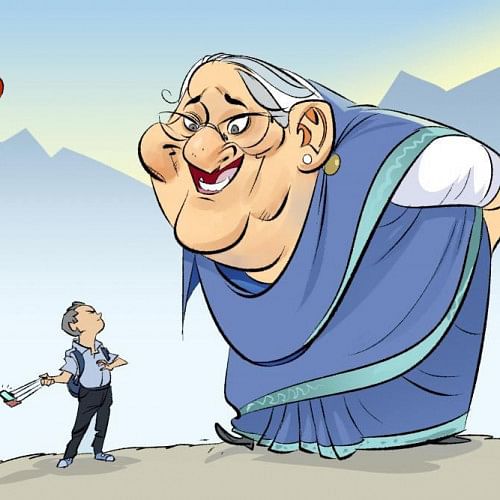
One of the most prominent cartoonists of the country, Mehedi Haque, traced the history of cartoons in the Indian subcontinent, emphasising their role in historical movements, including the Language Movement of 1952 and the Liberation War of 1971. Renowned artists like Zainul Abedin, Kamrul Hasan, and Qayyum Chowdhury used pseudonyms to create satirical cartoons during critical times. This tradition continues today, with a new generation of cartoonists connecting with audiences through the internet.

Mehedi pointed out that cartoons inherently oppose the status quo. While propaganda cartoons have been attempted by various governments, they often fail to resonate with the public. In contrast, dissenting cartoons remain etched in history. For example, Shishir Bhattacharjee's cartoons against the autocratic regime of Ershad were iconic. Mahatab Rashid and Natasha Jahan echoed this sentiment, emphasising that cartoons are a vital form of protest in the current political climate.
Over the past 15 years, political cartoons in Bangladesh have dwindled due to self-censorship. Cartoonists, including Mahatab Rashid, have been discouraged from directly targeting state leaders. However, the July uprising marked a turning point. Cartoonists overcame their fears and began to depict Sheikh Hasina and other leaders directly. This shift in approach was driven by a growing realisation that self-censorship was futile in the face of mounting violence.
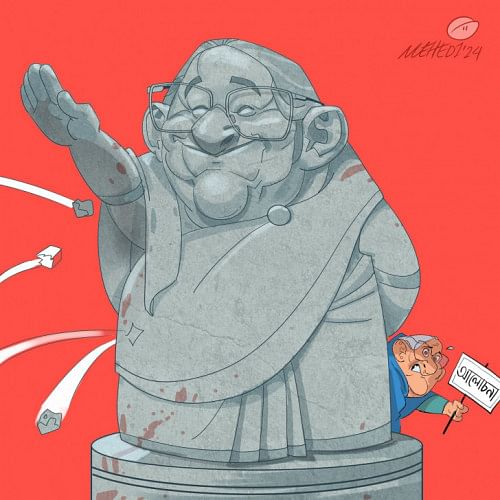
Natasha Jahan recounted how political cartoons featuring Sheikh Hasina and Khaleda Zia were once common in newspapers. Over time, these cartoons became symbolic representations. However, as the former ruling party's repression intensified in July, cartoonists returned to direct portrayals of the former prime minister.
Drawing political cartoons is risky, especially when targeting the ruling class. Cartoonists face harassment, imprisonment, and even death threats. Despite these risks, many artists, including Mehedi Haque, continued to create cartoons out of a sense of duty. He received multiple legal notices but remained undeterred, believing that the Digital Security Act (DSA), implemented by the previous government, could not stifle his art.
Mahatab Rashid noted a significant change in the political cartoon culture post-August 5. Newspapers, for the first time, published his cartoon featuring Sheikh Hasina. Social media and exhibitions have also provided platforms for political cartoons.
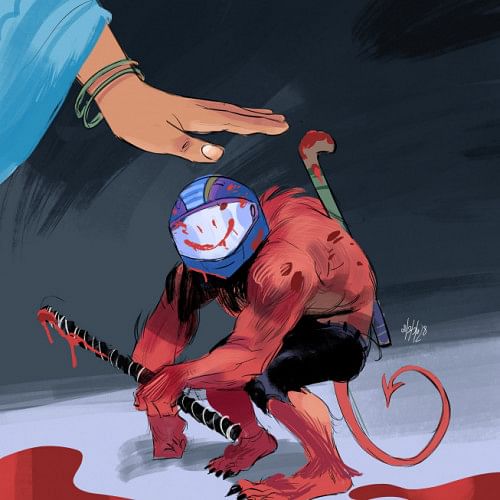
Natasha Jahan, who had to go into hiding after police visits, reflected on the importance of standing for truth. Despite the risks, she and others continued to draw for the sake of justice and truth. For Natasha, the act of creating meaningful art, even at the cost of her life, was a source of pride.
Natasha said, "I'm rather happy that they are coming to gather information because of my cartoons. That means I've made an impact. Back then, it felt like I needed to draw more. If my cartoons didn't bother them, they wouldn't have sought me out. Many of my fellow artists have gone through the same experience," she shared.
Obstacles are bound to arise, especially when one speaks against the ruling class, as the risks are higher. But one must continue working, and those who are conscious do just that. We witnessed this during the student movement, where various mediums, including cartoons, played a significant role.
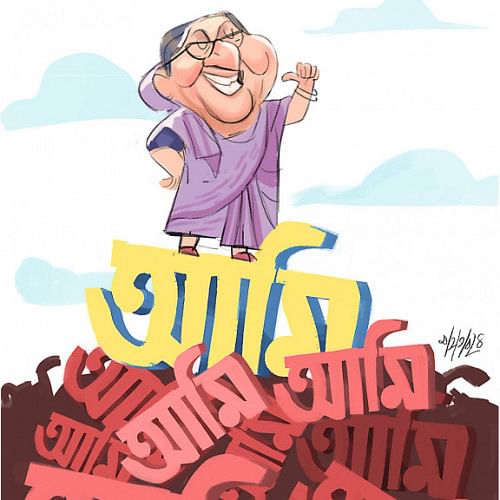
She added, "However, the new Bangladesh that emerged from this movement may no longer see such a ruling class in power—one that operates through imposed means and interferes with freedom. Like people from all walks of life, an artist, too, will work in their own way. In that scenario, they will have complete freedom, ensuring that power cannot influence them in any way."

Emphasising that cartoons should always be created, Mahatab said, "This movement has given a voice to everyone. During the movement, we discovered many new cartoonists. Many who didn't previously draw political cartoons have started doing so now. Some who were illustrators or animators also began drawing cartoons. I hope many of them will continue. Cartoons should always be drawn—there should be cartoons every day about daily life issues. During times of protest and unrest, they are essential, but cartoons should also address everyday issues like why Wasa's water is polluted or why there are so many cases being filed everywhere. Cartoons should be created about everything. No matter who is in power, even if it's my preferred leadership, there should be room for criticism."

Natasha believes that an artist must work on the side of truth. "It's easy to tell what is right and wrong. An artist must stand by the truth and call a spade a spade. My interest was in comics and creating different characters, but during the movement, I focused on political cartoons. This urge has to come from within—it can't be forced. However, an artist has their freedom. If they don't want to draw political cartoons, they won't. But if their work reflects the time, then history will also remember them," she said.
She added, "During a crisis, an artist must protest from their individual position. It's important to stand for the rights of the people, not for the government or those in power."
As Mehedi Haque pointed out, political cartoons cannot be forced; they stem from the artist's inner drive. During times of upheaval, like the July movement, cartoonists found their voice and connected with the people.
In this new Bangladesh, artists must continue to work freely, without fear of repression. Political cartoons should remain a staple of daily life, critiquing the government and addressing societal issues. The role of the artist is to stand on the side of truth, and in doing so, they empower others to do the same.
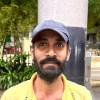
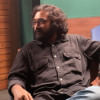
 For all latest news, follow The Daily Star's Google News channel.
For all latest news, follow The Daily Star's Google News channel. 
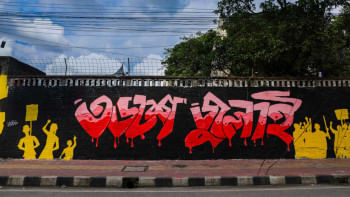


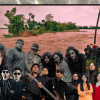


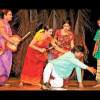


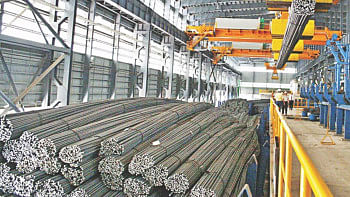
Comments